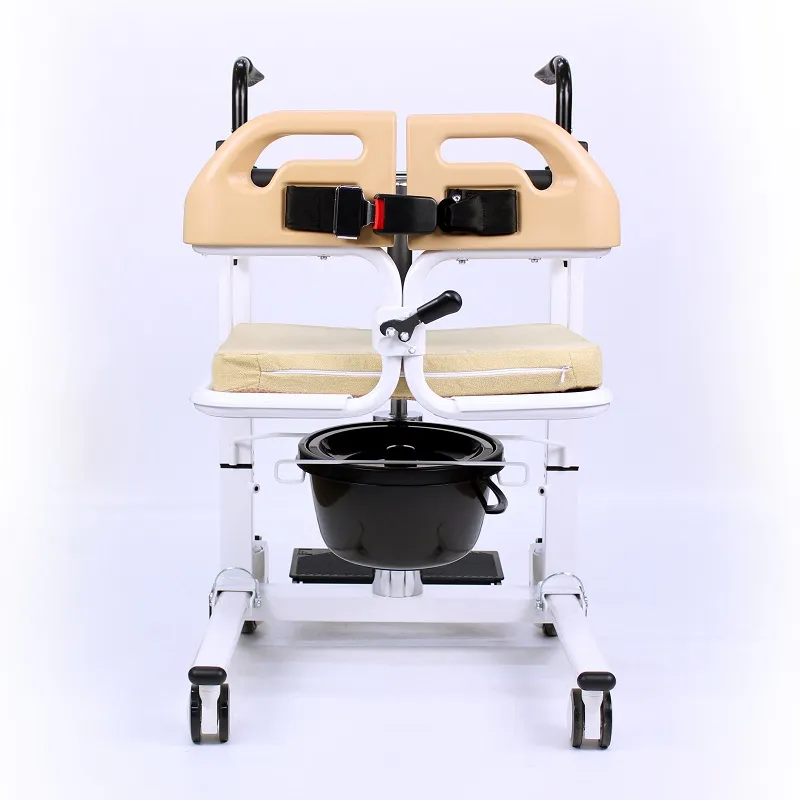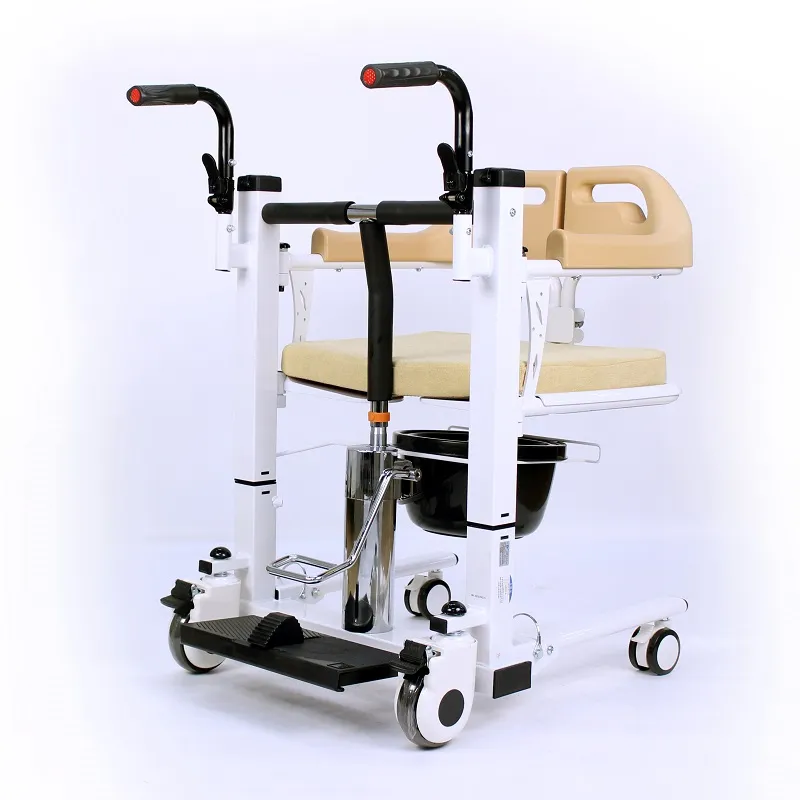In settings like elderly care, postoperative rehabilitation, and paralysis care, the increasing variety of wheelchairs is helping patients with diverse needs achieve more dignified and efficient mobility.
Among many wheelchairs, lift transfer chairs have gained increasing attention in recent years as a type of "multi-functional assisted transfer device," becoming increasingly well-known. However, many users remain unclear about the differences between lift transfer chairs and traditional manual or even electric wheelchairs, leading to common misconceptions when purchasing and using them.
This article will provide a comprehensive, systematic, and professional analysis of the core question, "What are the differences between lift transfer chairs and other wheelchairs?" to help consumers, caregivers, and medical professionals make informed choices.
What is a lift transfer chair?
A lift transfer chair, also known as a "patient lift transfer chair" or "patient transfer chair," is a specialized nursing assistance device that integrates lifting, transferring, and moving functions. It is widely used in hospitals, nursing homes, and home care settings. Its core value lies in helping people with mobility impairments safely transfer between different platforms, such as from a bed to a toilet, from a sofa to a wheelchair, or from a bathroom to a hospital bed.
Their notable features include:
· Vertical lift (some with electric systems);
· Openable seat design;
· Mobility casters and brakes;
· Most wheelchairs offer portable bathing and toileting functions.

What other types of wheelchairs are there?
The following are the common types of wheelchairs on the market:
1. Manual wheelchairs: Basic wheelchairs that rely on the user pushing the wheels or having someone else push them.
2. Electric wheelchairs: Equipped with batteries, a controller, and a motor, these wheelchairs are automatically moved by the user using a joystick.
3. Portable wheelchairs: Foldable and suitable for short trips.
4. Rehabilitation wheelchairs: Equipped with functions such as seat angle, backrest, and headrest adjustment, these wheelchairs are used for postoperative rehabilitation.
5. Multi-functional wheelchairs: Combine functions such as reclining, lying, and turning, but typically lack lifting and transfer capabilities.
Lift transfer chair vs. other wheelchairs: Structural design differences
1. Lift function: Does it support vertical movement?
· Lift transfer chairs: They feature vertical lift functionality, allowing the seat height to be adjusted to suit different target platforms (e.g., bed, toilet), eliminating manual lifting during transfers and preventing secondary injuries.
· Manual wheelchairs and other wheelchairs: They have a fixed height design and cannot be adjusted vertically. This requires an assistant to bend over and lift the patient, which is labor-intensive.
2. Transfer structure design
· Lift transfer chairs: Most chairs feature a retractable seat, with the backrest opening or folding back on both sides, allowing the patient to slide in and out smoothly and naturally.
· Manual wheelchairs and other traditional wheelchairs: They have a closed seat structure, requiring the user to stand up or be lifted to move, requiring high body control.
3. Mobility system
· Lift transfer chairs: Equipped with medical-grade silent universal wheels and a high-efficiency braking system, they offer both flexible steering and stable transfers in small spaces. · Manual wheelchairs: Designed with small front wheels and large rear wheels for self-propelling, they have a relatively large turning radius and are not suitable for precise docking in confined spaces.
Lift transfer chairs vs. other wheelchairs: Differences in Function and Use
|
Project |
Lift transfer chair |
Manual wheelchairs |
| Can it be raised and lowered freely? |
✔ Height adjustment available (some are electric) |
✘ Fixed height, requires manual assistance |
| Can it assist with toileting? | ✔ Most have a toilet opening |
✘ Not available |
| Is it suitable for confined spaces? | ✔ Suitable for use in narrow bathrooms and bedside areas |
✘ Can be easily restricted by space |
| Is it suitable for self-mobility? | ✘ Primarily used for nursing transfers |
✔ Can be self-propelled |
| Is it suitable for long periods of sitting or lying down? | ✘ Primarily for short-term transfers, with average comfort | ✔ Can be used for extended periods without stress |
| Is it suitable for bathing? | ✔ Mostly waterproof | ✘ Not suitable for wet or slippery surfaces |
As can be seen, the functional attributes of lift transfer chairs and manual wheelchairs do not completely overlap. Instead, they each have their own advantages and address different core scenarios.

Target Audience Analysis: Who is most in need of a lift transfer chair?
People who are most in need of a lift transfer chair:
1. People with complete or severe mobility impairments
2. People who frequently transfer within short distances
3. People with limited caregivers at home or in small nursing homes
4. People with temporary functional impairments
1. People with complete or severe mobility impairments
For example, those with paraplegia, those recovering from surgery, and the elderly who are bedridden, who are virtually unable to stand or transfer on their own. Manual wheelchairs require patients to have some ability to sit or push themselves, while lift transfer chairs allow patients to sit down without assistance, significantly reducing the burden on caregivers.
2. Those who frequently transfer within short distances
For example, elderly individuals who need to use the restroom at night and repeatedly move from bed to wheelchair and then to the bathroom. A lift transfer chair can serve as a multi-point "transfer station," eliminating the need for frequent equipment changes or patient lifting.
3. Those with limited nursing staff at home or in small nursing facilities
The lift transfer chair's "one-person transfer" design is very practical when one person is caring for multiple elderly individuals, or when family members are caring for elderly relatives.
4. Those with temporary functional impairments
For example, those recovering from car accident fractures or pregnant women with postpartum mobility issues, renting a lift transfer chair for a short period of time can improve their quality of life.
For those with good upper limb strength who can move around daily, such as paraplegics with intact upper limb function or those living alone with mild to moderate mobility impairments, a manual wheelchair is more suitable, offering greater autonomy.
Lift transfer chair vs. other wheelchairs: Differences in the care process
1. Lift transfer chair: Participates in the "transfer process"
The chair's greatest value lies in assisting patients in the "intermediate process" from location A to location B. It does not inherently require long-term travel or transportation.
2. Manual Wheelchairs: Participating in "Continuous Travel"
Manual wheelchairs are used all-weather, continuously, and are commonly found in hospital corridors, rehabilitation training rooms, and parks. Users rely on them for mobility, daily communication, and outdoor activities.
Thus, within a complete care process, a lift transfer chair is responsible for "transferring" while a manual wheelchair is responsible for "daily mobility." The two work together, not as a replacement.
Lift Transfer Chair vs. Other Wheelchairs: Price and Maintenance Differences
|
Project |
Lift transfer chair |
Manual Wheelchairs |
| Average Market Price | ¥2000 - ¥8000 | ¥1000 - ¥4000 |
| Electric Power Available | ✔ (Select models) | ✘ Mainly manual |
| Charging and Maintenance Required | Electric models available, requiring regular charging | No charging required, simple structure |
| Structural Complexity | High (including lift mechanism) | Low maintenance (push mechanism) |
| Service Life | 3-6 years (depending on frequency of use) | Over 5 years |
Lift transfer chairs are more mechanically complex, requiring stricter requirements for material strength, drivetrain, and brake structure, and are therefore relatively more expensive. Regarding maintenance, if the lift system is powered, the motor and control unit must also be regularly inspected.

Misconceptions About Lift Transfer Chairs
Misconception 1: Lift transfer chair = wheelchair
In reality, a lift transfer chair is a "nursing transfer device." Its design focus is not long-term comfort, but rather short-term transfer convenience.
Misconception 2: If you already have a wheelchair at home, you don't need a lift chair
In practice, the most challenging step is moving from bed to wheelchair, not the actual wheelchair itself.
Myth 3: A lift transfer chair cannot replace all wheelchair functions
It lacks the ability to push itself, sit or lie down for extended periods, or move outdoors. Therefore, it must be used in conjunction with a manual or electric wheelchair.
Does Dayang Medical produce electric wheelchairs?
Yes, electric wheelchairs are one of our main product lines. As a leading manufacturer in China, Dayang Medical supplies a wide range of electric wheelchairs with advanced technology, high quality, and competitive wholesale prices. Our electric wheelchairs are CE, FDA, and TUV certified, making them safe and reliable for global buyers.
We also offer wholesale discounts and promotions for bulk purchases. Dayang Medical is a trusted China supplier for electric wheelchair sales and supply at factory-direct prices.










